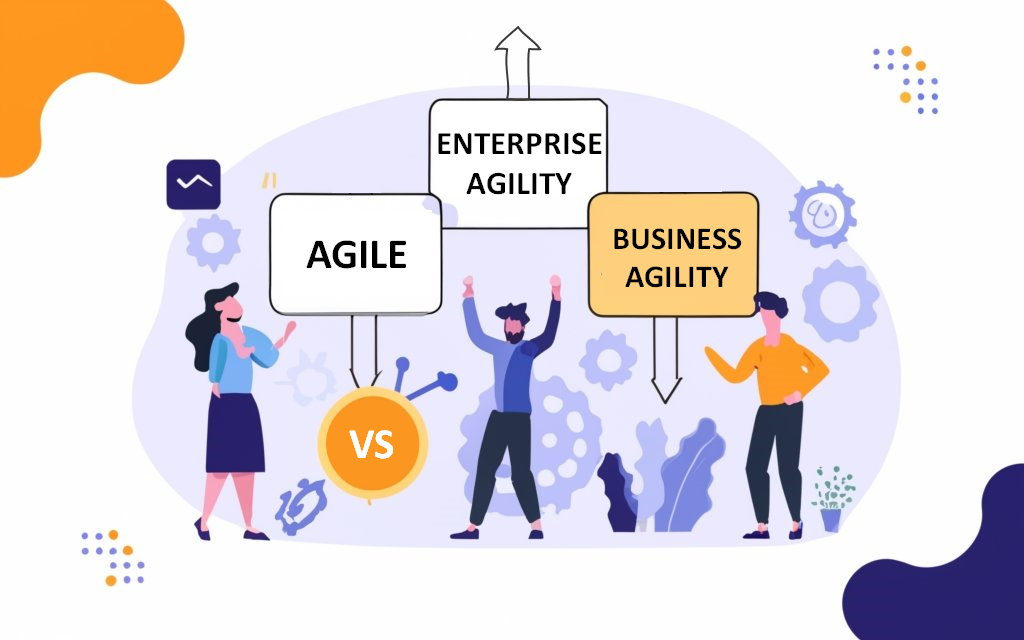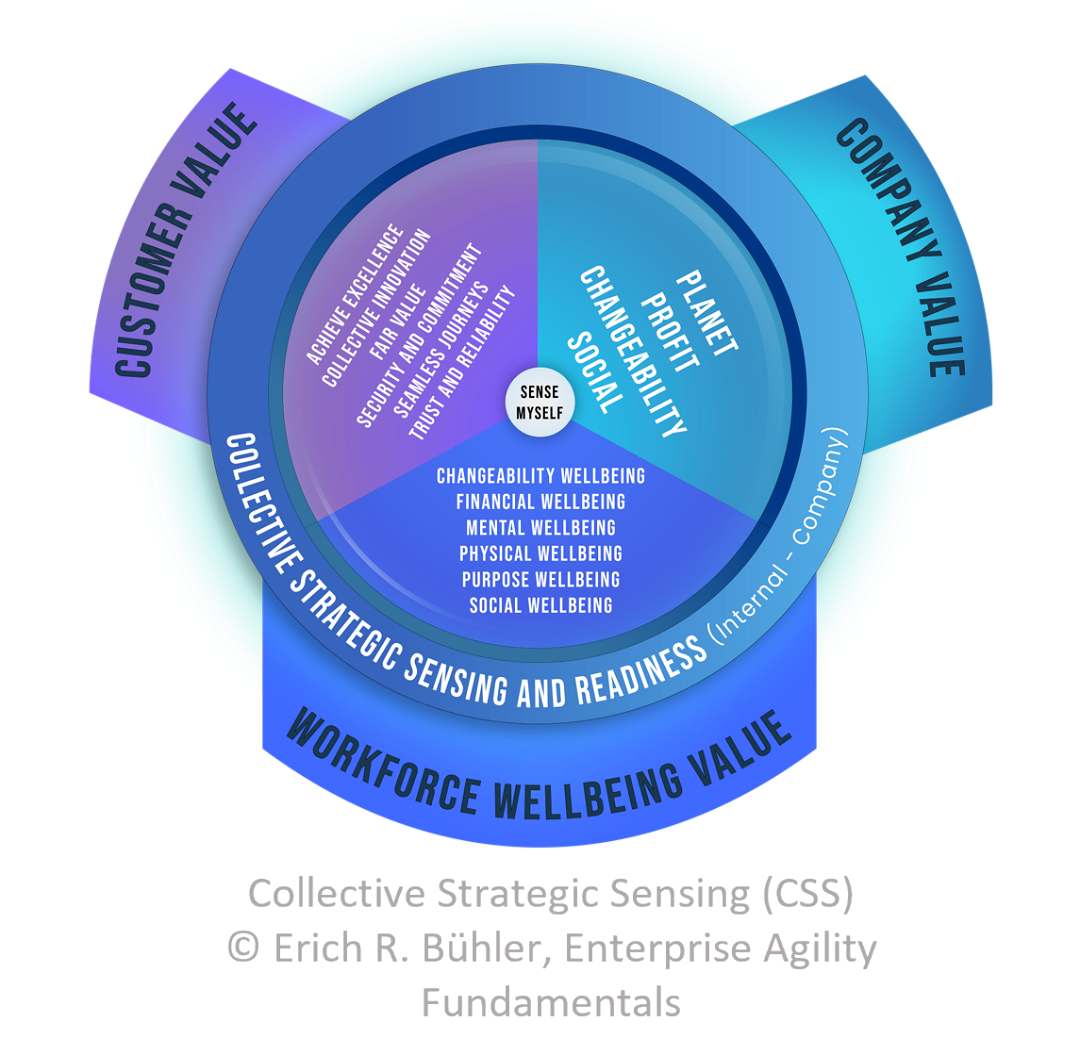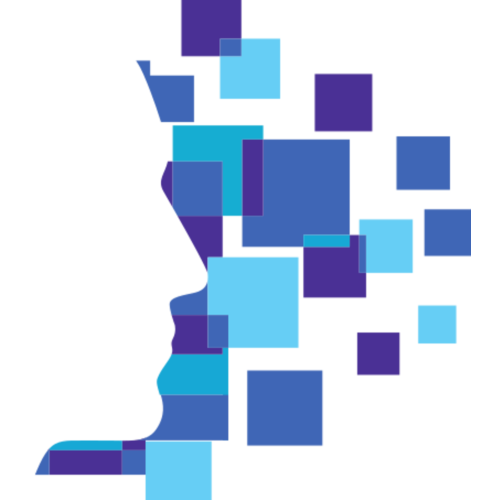
Enterprise Agility offers a more comprehensive approach. It provides an integrated ecosystem to build organizational resilience on multiple levels. A key difference is Enterprise Agility's scientific foundation, incorporating insights from behavioral science, neuroscience and strategic mobility models.
Another distinction is Enterprise Agility's holistic perspective on value creation. While agile and business agility focuses mainly on customers, Enterprise Agility promotes a TriValue Company Model that also considers company value and workforce wellbeing value. By balancing these three areas, organizations can drive sustainable growth.
Enterprise Agility gives companies an ecosystem to continuously reinvent themselves. Let's explore how business agility and Enterprise Agility are related but different concepts:
- Business agility refers to the ability of a company to quickly adapt and respond to changing market conditions and customer demands. It focuses on agility in business operations and processes with a customer-focused approach.
- Enterprise agility encompasses business agility but goes beyond it. Enterprise agility is about creating an adaptive, innovative, resilient organization across all levels - from leadership to operations. It also proposes a different financial and value creation model (TriValue Company), social contracts (how you influence the culture), and others.
The Enterprise Agility Body of Knowledge represents the Agile or its evolutions on the left-hand side and Enterprise Agility on the right-hand side. Agile or business agility current methods cannot deal with accelerated markets or disruption in the business models. They can deal with disruption at the product level, and that is a crucial difference.
Frameworks like Scrum, XP, Kanban, Lean, and their evolutions were created during times of relative stability and predictable change. They optimize for relatively stable business models undergoing incremental innovation. These methods focus on iterating products/services to meet emerging customer needs. But they lack capabilities to sense potential disruption of entire business models or ecosystems and deal with them effectively without panicking.
Agile frameworks leverage timeboxed sprints to release new features quickly. However, exponential change can soon make these new features irrelevant if the underlying business model is disrupted. Scaling agile with frameworks like SAFe, for example, improves cross-team alignment but does not fundamentally alter hierarchical leadership styles or mental models. This limits sensing weak signals and imagining alternate ecosystems.
Additionally, a customer-centric approach to value creation, while beneficial, does not consider the multi-dimensional nature of value in the face of disruption. Shareholders, employees, partners, society—their needs also require balancing and this is where the TriValue Company model comes into play.
Prepares for Non-Linear Futures
In today's landscape of exponential change and AI, business model disruption can rapidly make companies irrelevant unless they develop new senses, strategies and structures. Enterprise Agility aims to fill this gap by equipping organizations to continuously reinvent themselves for non-linear futures. But Enterprise Agility is not a replacement for existing framework, but aims to complement and enhance existing ways of working. The models and principles can help organizations maximize the potential of familiar methods.
Some key differences:
- Business agility is more tactical, while enterprise agility is strategic. Business agility aims to make business processes and workflows more flexible and iterative. Enterprise agility aims to transform the entire organization's culture, structures and leadership with different social models, business and financial value creation, etc.
- Business agility is focused on improving agility in linear growth markets. It focuses on product disruption. Enterprise agility involves enabling agility across the whole organization during accelerated times, high uncertainty, and ambiguity. Enterprise Agility can deal with product and business model disruption.
- Business agility methods evolved from software development and the Agile manifesto 2001. Enterprise agility evolves from new concepts created in 2018. It incorporates a broader range of disciplines including the science of accelerated change and others.
- Enterprise agility emphasizes long-term adaptability, sustainability and resilience, while business agility focuses on responsiveness to immediate market changes.
- While agile frameworks provide tactical practices for teams and products, Enterprise Agility offers a flexible, adaptive ecosystem for enterprise-wide agility during accelerated change. It enables a systemic, broad-based approach tailored to the organization's unique situation and the new fast-paced AI reality.
- Enterprise Agility provides a holistic perspective that extends beyond immediate teams and products to the broader organization, customers, partners, society, and environment.
So, business agility is an important capability, but Enterprise Agility represents a more comprehensive, robust, and strategic approach to organizational agility and resilience. Enterprise agility seeks to build adaptive capacity across all levels of an organization, placing the focus on sustainability in times of accelerated change and AI.
While frameworks such as SAFe, Scrum, and business agility models from several providers deliver valuable capabilities, Enterprise Agility provides additional tools to enhance these approaches.
For example, integrating Enterprise Agility into SAFe can strengthen alignment, leadership, and workforce mobilization across the organization. Universal agreements can forge new social contracts, even when SAFe mandates cross-team coordination. The TriValue Company Model offers a new framework for financial and business value creation that expands beyond SAFe's customer-centric approach.
When combined with Scrum, Enterprise Agility frameworks such as the TriValue Company Model and Future Thinking offer more holistic value creation and market discovery capabilities that go beyond Scrum's iterative delivery focus.
Supports Existing Frameworks
Rather than completely replacing existing concepts, combining Enterprise Agility allows organizations to get the best of both approaches. It improves the effectiveness of current methods by introducing new capabilities to cope with the growing complexity of exponential markets.
Enterprise agility improves the effectiveness of current methods in several important ways:
- It equips organizations with new frameworks and tools designed specifically for the new challenges of exponential markets, where disruption is frequent and unpredictable. Traditional models offer less guidance for managing massive uncertainty.
- It incorporates the latest scientific findings on human behavior, neuroscience, and behavioral science. This enables a more nuanced understanding of organizational change in turbulent environments compared to periods of stability.
- It focuses on cultivating the future thinking, innovation ecosystem and collective capabilities required to adapt to sudden market changes. Traditional methods offer less support for future-oriented agility.
- It enhances leadership capabilities in areas such as intellectual humility, tolerance for ambiguity and leadership robustness. Existing approaches offer limited development of these critical capabilities for times of volatility.
- It strikes a balance between efficient sensing, execution, exploration, experimentation and the rapid testing of new ideas through quick iterations. This is in contrast to traditional models that focus on predictable execution.
In essence, enterprise agility expands both the mindset and the toolset for organizations to succeed in the face of increasing complexity, speed of innovation and unpredictability. It brings new capabilities that complement and enhance current methods optimized for more stable conditions. The result is greater organizational effectiveness.
Introduces the Science of Accelerated Change
Enterprise Agility introduces robust structures from the science of accelerated change to prepare organizations for future upheaval. In particular, the neuroscience of change provides insights into how people process change at a neurological level. This enables leaders to implement organizational change initiatives in line with natural thought patterns.
In addition, behavioral science offers models to influence cooperative behavior even in the face of uncertainty.
Finally, Strategic Mobility helps organizations and leaders develop the cognitive flexibility to quickly realign people with new priorities in response to sudden change.
Frameworks such as the Change Journey Pyramid or the M-Leadership Framework show how to overcome inertia and resistance by reshaping mental models.
The way to build social contracts during accelerated change and the MLE framework provides a new way to shape a culture during the upheaval.
Together, these interdisciplinary sciences ensure that enterprise agility is grounded in evidence-based models to maintain highly engaged and adaptable workforces. Organizations can evolve their approaches to agility using frameworks tailored to exponential disruption and accelerated learning.
While business agility focuses on customer needs, the Science of Accelerated Change expands Enterprise Agility to include models that prepare organizations for any type of disruption while ensuring employee wellbeing. This multidimensional perspective strengthens resilience.
Builds a Sustainable Ecosystem
Enterprise Agility is based on sustainability from its roots when exposed to a high number of external changes. The Sustainability Zones framework in Enterprise Agility provides a roadmap for organizations to build resilience and continuous adaptability.
The six Sustainability Zones range from 'Apathy' where change is resisted, to 'Harmony' where reinventing the business model is a natural capability. As companies progress through the zones, they develop greater senses, skills and structures for shared progress amidst uncertainty.

In the early zones, sustainability depends on stability. But in higher zones, sustainability means embracing change as an opportunity for conscious evolution. Organizations develop the vision and vitality to navigate non-linear disruption and co-create emerging futures.
Embedding Enterprise Agility allows organizations to understand their current sustainability level. Steps can then be taken to cultivate the mindsets, relationships, and innovations to progress across zones.
This builds strategic muscles and collective capabilities to rapidly respond to both incremental and exponential change. Rather than stability, sustainability gets redefined as continuous learning and adaptation for the benefit of all stakeholders.
The Sustainability Zones provide crucial perspective to develop Enterprise Agility. They highlight that agility is not an end state, but an ongoing journey of potential realized through new forms of leadership, collaboration and mutual understanding.
Prepares an Ecosystem Ready for the Future
Enterprise Agility also provides differentiated support for the present and future with Future Thinking, which is part of the TriValue Company Model. Future Thinking offers a bifocal approach—0 to 12 months timeframes are addressed through Spot Indicators, something relatively similar to OKRs but designed for highly uncertain environments. The 12-month to 3-year timeframe is guided by Futures (Indicators) and frameworks like the Shared Progress Stock Exchange to embrace uncertainty dynamically.
Spot Indicators focus on meeting current customer, company and employee needs—the day-to-day business. They are more stable metrics providing continuity amidst change.
Futures (Indicators) take a speculative approach to envision potential scenarios and opportunities on the horizon. They prepare organizations for disruption and non-linear possibilities.

Using both together enables continuity and progress. Spot Indicators drive incremental innovation while Futures (Indicators) set the stage for more transformational changes. Companies sustain current business models while inventing new ones.
Additional Enterprise, the Shared Progress Stock Exchange, helps teams collaboratively explore multiple alternate futures. Small bets are placed on high-potential scenarios. Plans adapt rapidly as ambiguity resolves through market sensing.
Future Thinking gives organizations the tools to balance optimization in the present with options for the future. It allows companies to iterate today's products and services while experimenting with ideas that may become tomorrow's business models. This builds resilience against disruption.
As you can see, Future Thinking provides a way to govern the organization for the now and the next. It is one of the key tools within Enterprise Agility to develop continuity and consciousness—to sustain what provides value today while evolving for long-term relevance.
Introduces New Foundations for Change Professionals
Enterprise Agility also provides 12 Accelerated Change Principles to guide change consultants and agilists in creating better frameworks and models to deal with market acceleration.
These principles synthesize insights from diverse fields including neuroscience, behavioral science, strategic mobility and others. They act as design criteria for developing organizations capable of continuous adaptation.
Together, the principles paint a picture of the leadership capacities, social ecosystems, and workforce environments essential to evolve business models and practices. They provide transformation guidance for a world that demands perpetual learning and innovation.
These principles are like genetic code—they inform the entire structure and functioning of fit-for-future organizations. They enable agility at the deepest levels to become an organizational way of life rather than just a set of practices.
For change leaders, the principles offer a blueprint to architect organizational cultures, strategies, and collaborations ready for exponential futures. They guide the creation of regenerative systems poised to continuously co-create emerging realities.
The Accelerated Change Principles empower agile practitioners to reach for more ambitious horizons. They provide the insights and inspiration to build beyond incremental improvements toward transformational enterprise agility.
Uses AI Hypercustomization for frameworks
Many companies today adopt popular frameworks like Scrum or SAFe to increase flexibility and resilience and deal better with emergent situations. However, these models often require extensive customization and adaptation to fit the unique needs and culture. This process can be challenging, requiring significant time and effort from teams and change professionals.

Enterprise Agility offers a revolutionary approach called Hyper-customization. Instead of taking a one-size-fits-all model and attempting to reshape it, Enterprise Agility leverages AI and Machine Learning to dynamically adapt frameworks to each organization’s characteristics and objectives. Here’s how hyper-customization in Enterprise Agility works:
Data Collection
The process starts by gathering data on the company’s structure, workflows, objectives, and culture. This is done through surveys, interviews, observation, and analysis of existing documentation. The goal is to deeply understand the organization’s unique attributes.
AI Analysis
The collected data about the company is fed into Enterprise Agility University’s AI (Hanna AI or Laura AI) as a prompt. AI analyzes the company’s unique characteristics and dynamics and existing frameworks to deeply understand what adaptations will be most impactful and sustainable. The frameworks are then customized by the AI, taking into account key areas like employee engagement, leadership behaviors, and long-term sustainability. The goal is to shape the framework specifically to the organization’s culture and objectives. This also includes adapting the EA frameworks to a specific industry.
Framework Customization
Based on the AI’s recommendations, fine-tuned adjustments are made to the framework’s processes, rituals, governance, and principles by the consultant or other members of the company. This creates a tailored version catered to the enterprise.
Continuous Optimization
As the organization evolves, the AI continues collecting data and making changes to keep the framework optimized. Agility teams also give feedback to drive ongoing improvements.
Champions an Open Source Approach to the World
As of October 15, 2023, all Enterprise Agility frameworks, models, and supporting theories are open source. There is an important reason for this decision.
Enterprise Agility recognizes that no single institution can tackle the complex challenges facing organizations today. The mindset required for exponential times requires a radically transparent exchange of ideas between different contributors.
By making these models available as open source, continuous improvement through global collaboration becomes possible. Anyone can build on them, adapt or improve them using Creative Commons 4.0 rules. Local contexts and disciplinary perspectives add new dimensions to the framework models.
This fosters a spirit of intellectual humility - and the realization that no one has all the answers. As disruption accelerates, agility must also evolve rapidly. Open contributions accelerate this development.
The commercial intent behind enterprise agility has always been to spread these models widely, not restrict them. While education and support services come at a price, the intellectual property itself must be distributed freely. With this move, we hope to spark innovation networks for organizational agility that goes beyond existing frameworks and models.
Ultimately, openness enables greater resilience. Shared insights make us all smarter together. We look forward to Enterprise Agility growing beyond its roots through an open-source ecosystem for organizations to thrive.

Check the 160+ models and frameworks in the EA ecosystem here or read more at Enterprise Agility Fundamentals available for free here.
